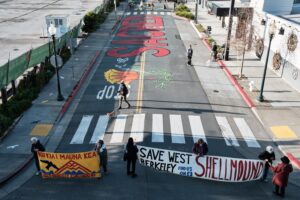At the junction of two of Oakland’s major thoroughfares, traffic has come to a stop. Auto traffic, that is. The Latham Square Public Plaza opened on August 16th directly in the middle of Telegraph and Broadway as an experimental design to reenvision urban streets as space for all kinds of traffic.
With grant funding and an area of road already set for redesign, the city of Oakland, the Downtown Oakland Association, and the San Francisco-based design firm Rebar, seized the unique opportunity to create a public space that, according to the city, “enhances the pedestrian environment; increases economic development potential; saves existing trees; improves private automobile and transit operations.”
The $170,000 project is part of the growing movement to rethink public space, which is taking off in major urban hubs around the world. Unlike “parklets,” mini-parks built in parking spaces, which have become established in San Francisco and other cities, this plaza converts the roadway itself into a unified public space.

“Like many cities, Oakland is one-fourth public right-of-ways,” said Jamie Parks, Oakland’s Complete Streets program manager.
Parks said there are many unused pavements that can and should be used for more than just automobile traffic. The Latham Square Public Plaza is part of the new Complete Streets policy, which requires that all forms of transportation — including bicycle and pedestrian traffic — be considered when planning roadways.
Blocked off from the flow of traffic by repurposed lamp posts and a giant “Latham” sign made of old road signs, the Latham Square Public Plaza is comprised of artfully designed planters and benches resting on pavement painted in the sweeping blue and green stripes pattern of the Downtown Oakland logo. But the paint on the road is the most permanent facet of the park. All of the other pieces can be picked up and moved as the city and the public see fit.
“[In public planning], we are usually afraid of trying something and failing,” Parks explained.
This project, however, defies this norm and is all about trial and error. The plaza experiment will last at least until the end of the year, and even as long as until next summer, when a permanent design for the intersection of Telegraph and Broadway will begin construction.
Until then, city officials will monitor the activity of the plaza to evaluate its success. Beginning in September, Popuphood will install mobile retail stalls in the plaza through the holiday season to attract foot traffic, and in October, southbound Telegraph will be reopened to see how the plaza functions with one direction of traffic going by it.
Parks and others who have worked on the plaza are optimistic about the future of Latham Square, despite concerns that the plaza may cause congestion on the surrounding roadways or add to vandalism in the area. As the park is being used as a living lab of sorts, there will be plenty of opportunities to move things around to determine what works best in the plaza.
“We’re testing and experimenting,” Parks said.
Jaquelyn Davis is a Bay Nature editorial intern.





